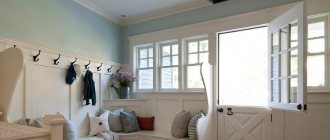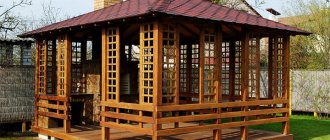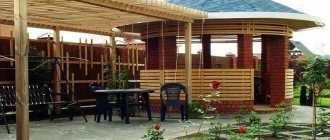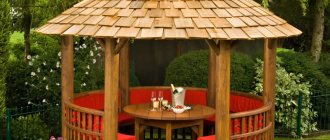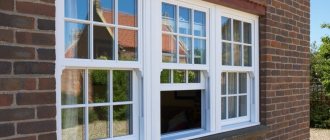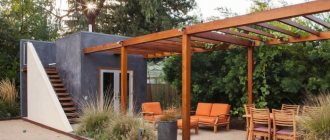Rest in the gazebo is quite often disrupted by gusts of wind or rain. It is impossible to influence the vagaries of the weather, but it is possible and even necessary to protect yourself from its consequences!
Taking refuge in the gazebo, you will once again experience the comfort and thrill of spending time at the countryside.
Idea for a gazebo
This publication will list all known methods of protecting a gazebo from rain and wind.
Some of the proposed options will only partially protect you from bad weather, while others will create an absolutely comfortable atmosphere indoors.
Glazing
PVC film
Closing window openings with PVC film will provide complete shelter from wind and rain. The cost of such glazing will be a pittance compared to massive double-glazed windows and Euro-windows, but the efficiency is very high.
The main thing is to attach the film to the gazebo aesthetically and carefully. This can be done using special fasteners or regular staples.
This method will most effectively close the gazebo from the wind. In the photos this whole thing looks very decent, but in reality it turns out even better. Highly recommended!
Plastic Eurowindow
The most reliable way would be to install plastic euro-windows.
This option refers to a warm type of glazing, which means you can not only shelter from rain and wind, but also create a comfortable temperature inside using heaters.
Read more about this approach to relaxation in publications about warm and winter gazebos.
Frameless glazing
An original way can be considered the use of frameless glazing, which can be expanded and folded.
This is more relevant for summer holidays, when it is necessary to protect yourself from gusts of wind and drops of rain. In the cold season, this is not so interesting due to the fact that this method is a cold type of glazing.
Instructions for covering with polycarbonate
- Polycarbonate can be attached to special thermal washers or special screws.
- To attach this material, you need to drill holes, stepping back a few centimeters from the edge.
- A film must be applied to the layer that will be on top to protect it from direct exposure to sunlight. Therefore, the sheets must be attached so that the film is on top.
- Condensation must be able to drain downwards. You need to attach a plug to the bottom of the end, and cover the end with an end profile from above.
- If the connection is expected to be airtight, special profiles must be used.
You can also create sliding windows from polycarbonate, which is a good way to protect the gazebo from rain in the fall and snowfall in the winter. Since polycarbonate is the most convenient to use, this will allow you to make window frames in a short period of time. Complex structures with arches and other structures can be built from this material.
Curtains (tarpaulin, fabric)
If your building is of an open type, then installing any windows poses certain difficulties.
In this case, you can use massive curtains that will partially protect people in the gazebo from weather influences.
It is best to give preference to heavy and dense fabrics like tarpaulin. It will be necessary to consider the mounting not only on the cornice, but also on the support pillars.
Only by pulling the fabric tightly can you achieve at least something in terms of protection, otherwise you will get nothing but discomfort and “exposed” nerves.
Plastic euro window
Unlike the previous one, this type is warm, since you can purchase a heater for warmth. Also, gazebos closed from the wind in this way have a number of advantages:
- Safe and strong structures.
- Can be used at any time of the year.
- Good wind protection.
Even though it is a durable design, most people prefer natural materials.
Anti-mosquito net (an interesting way!)
I saw this approach from Dmitry Maltsev, who was building his 3 by 3 meter gazebo. It will protect you from wind, mosquitoes, light rain and sun.
Gazebo covered with mesh
The point is this:
Attaching the mesh to the frame
- Buy a cheap roll of mosquito net. For example, in Leroy Merlin.
- The entire external area is covered with a layer of this mesh and “tightly” attached around the perimeter.
- The mesh holds back light rain, wind, and also creates darkness in the room.
The idea really works, even if it does not completely solve the issue of protection. It's definitely worth taking note of.
landscaping
Among the many options for closing a gazebo, one can highlight a rather unusual method. This is landscaping with climbing plants. This method of covering will not only protect from bad weather in the summer, but will also give the gazebo a magnificent look. This method is only suitable for short-term use; in other seasons it is worth providing a different type of shelter, as well as curtains and mosquito nets.
Structural elements
Decorative lathing
Recently, almost all gazebos are sold with wooden sheathing. This is not only beautiful and aesthetically pleasing, but also allows you to achieve the following effects:
The grille partially blocks wind and rain.
A good atmosphere is created inside, especially with a large number of people, when such bad weather is not an obstacle to relaxation.
People inside the gazebo are not visible, but they, in turn, perfectly see everything that is happening on the street. This is very convenient in those moments when you want to close yourself off from the attentive gaze of others.
Sheathing with polycarbonate, clapboard or boards
If the design of the building allows you to attach cladding material to it, then you can completely protect yourself from any natural disasters.
As cladding, you can use polycarbonate slabs, lining of any class or ordinary edged boards.
Two finishing options are possible:
- “Tightly” close the walls.
- Partially close the walls.
The second option looks more interesting, but is less effective. Rain and wind will easily pass through the casing. The first option will completely cover the gazebo, but will do so to the detriment of its appearance.
Features of the roof structure of a closed porch
We need to start talking about a closed porch with the roof. Why?
- Firstly, this is the protective part of the structure, which is responsible for preventing natural loads from penetrating into the premises.
- Secondly, this is, in fact, a continuation of the roof of the house itself. Therefore, the requirements for the porch roof are quite strict.
- Thirdly, as with all building structures, there are strength requirements for the porch roof.
Based on the first position, we can say this. There are a huge number of roofing materials that are used today in the construction of roofs, large and small. But since the closed porch of a house is a small room, it is possible to use lightweight materials to cover it. For example, flexible tiles.
For the second position. Designers believe that the (closed) porch must be covered with the same roofing material as the main building itself. As practice shows, this is not always applied in practice. Look at the photo below, where the house is covered with tiles and the porch roof is clear polycarbonate. It looks very original and airy.
Position number three. Snow and rain loads greatly affect the design of the porch roof. But in the modern world, especially in the field of construction, there is no need to use any complex and heavy materials to make the roof, and indeed the entire structure, durable. There are a large number of modern lightweight materials and products that can withstand fairly decent loads. For example, aluminum profiles.
Therefore, pay attention to the photo below, which shows such a vestibule in the form of a small house attached to the main building. The entrance to the house is completely closed, but the vestibule itself is equipped with windows and an entrance door. To build it, in addition to the porch itself, it was necessary to build walls, install a door at the entrance and windows on the sides. At the same time, the walls are raised to a certain level.

